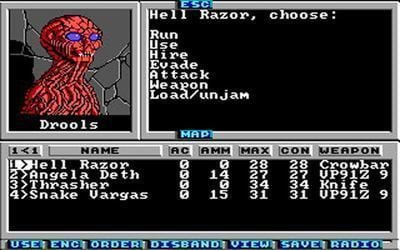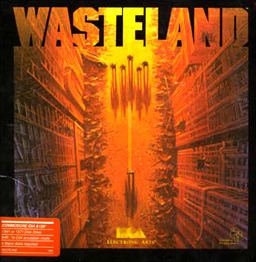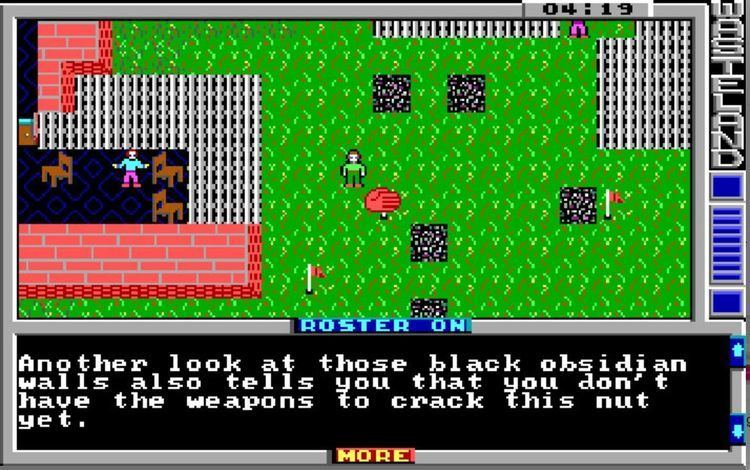8.8 /10 1 Votes
4.5/5 GOG Producer(s) David Albert | 9/10 Steam 4.3/5 My Abandonware Programmer(s) Alan Pavlish Initial release date 1988 | |||||||||||||||||||||||||||||||||
 | ||||||||||||||||||||||||||||||||||
Artist(s) Todd J. CamastaBruce SchlickberndCharles H. H. Weidman III Platforms Similar Fallout: New Vegas, Fallout 3, Fallout 4, Fallout, Fallout: Brotherhood of Steel | ||||||||||||||||||||||||||||||||||
Wasteland is a science fiction open world role-playing video game developed by Interplay and published by Electronic Arts in 1988. The game is set in a futuristic, post-apocalyptic America destroyed by nuclear holocaust generations before. Developers originally made the game for the Apple II and it was ported to the Commodore 64 and MS-DOS. It was re-released for Microsoft Windows, OS X, and Linux in 2013 via Steam and GOG.com, and in 2014 via Desura.
Contents

Critically acclaimed and commercially successful, Wasteland was intended to be followed by two separate sequels, but Electronic Arts' Fountain of Dreams was turned into an unrelated game and Interplay's Meantime was cancelled. The game's general setting and concept became the basis for Interplay's 1997 role-playing video game Fallout, which would extend into the Fallout series. Game developer inXile Entertainment released a sequel, Wasteland 2, in 2014, and announced plans to release a third game in winter 2019.

Gameplay

Wasteland's game mechanics are based on those used in the tabletop role-playing games, such as Tunnels and Trolls and Mercenaries, Spies and Private Eyes created by Wasteland designers Ken St. Andre and Michael Stackpole. Characters in Wasteland have various statistics (strength, intelligence, luck, speed, agility, dexterity and charisma) that allow the characters to use different skills and weapons. Experience is gained through battle and skill usage. The game generally lets players advance using a variety of tactics: to get through a locked gate, the characters could use their picklock skill, their climb skill, or their strength attribute; or they could force the gate with a crowbar or a LAW rocket.

The player's party begins with four characters. Through the course of the game the party can hold as many as seven characters by recruiting certain citizens and wasteland creatures. Unlike those of other computer RPGs of the time, these non-player characters (NPCs) might at times refuse to follow the player's commands, such as when the player orders the character to give up an item or perform an action. The game is noted for its high and unforgiving difficulty level. The prose appearing in the game's combat screens, such as phrases saying an enemy is "reduced to a thin red paste" and "explodes like a blood sausage", prompted an unofficial PG-13 sticker on the game packaging in the U.S.

Wasteland was one of the first games featuring a persistent world, where changes to the game world were stored and kept. Returning to an area later in the game, the player would find it in the state the player left it in, rather than being reset, as was common for games of the time. Since hard drives were still rare in home computers in 1988, this meant the original game disk had to be copied first, as the manual instructed one to do.
Another feature of the game was the inclusion of a printed collection of paragraphs that the player would read at the appropriate times. These paragraphs described encounters and conversations, contained clues, and added to the overall texture of the game. Because programming space was at a premium, it saved on resources to have most of the game's story printed out in a separate manual rather than stored within the game's code itself. The paragraph books also served as a rudimentary form of copy protection; someone playing a copied version of the game would miss out on much of the story and clues necessary to progress. The paragraphs included an unrelated story line about a mission to Mars intended to mislead those who read the paragraphs when not instructed to, and a false set of passwords that would trip up cheaters.
Plot
In 2087, generations after the devastation of a global nuclear war in 1998, a distant remnant force of the United States Army called the Desert Rangers is based in the Southwestern United States. A team of Desert Rangers is assigned to investigate a series of disturbances in nearby areas. Throughout the game, the rangers explore the remaining enclaves of human civilization, including a post-apocalyptic Las Vegas.
As the group's investigation deepens, the rangers discover evidence of a larger menace threatening to exterminate what is left of humankind. A pre-war artificial intelligence computer operating from a surviving military facility, Base Cochise, is constructing armies of killer machines and cybernetically modified humans to attack settlements with the help of Irwin Finster, the deranged former commander of the base. Finster has transformed himself into a cyborg under the AI's control. The AI's ultimate goal is to complete Project Darwin, which Finster was in charge of, and replace the world's "flawed" population with genetically pure specimens. With the help from a pre-war android (robot) named Max, the player recovers the necessary technology and weapons in order to confront the computer at its base and stop it by making the base's nuclear reactor melt down.
Release
Released after five years of development, Wasteland was distributed for the Apple II and ported to the Commodore 64 and PC DOS platforms in 1988 — it is sometimes erroneously listed as being published in 1987, because that year appears on the title screen of the Apple version. While all versions were nearly identical in terms of gameplay, the EGA PC port had upgraded graphics (there was also a CGA version), although the C64 boasted the best sound. The PC version differed by having an additional skill called "Combat Shooting" which could be bought only when a character was first created.
Wasteland was re-released as part of Interplay's 10 Year Anthology: Classic Collection in 1995, and also included in the 1998 Ultimate RPG Archives through Interplay's DragonPlay label. These later bundled releases were missing the original setup program, which allowed the game's maps to be reset, while retaining the player's original team of Rangers. Jeremy Reaban wrote an unofficial (and unsupported) program that emulated this functionality.
On November 12, 2013, the game was re-released for Microsoft Windows and OS X on GOG.com, re-branded as Wasteland 1 - The Original Classic. The next day, the game was also re-released on Steam for the Windows, Mac and Linux. As the game suffered in the re-released version still from a critical timing bug, a fan developed a unofficial patch which was included November 2013 in the official patch 2. The patch from April 2014 fixed a Linux-specific bug and added another soundtrack.
Reception
Computer Gaming World cited Wasteland's "ease of play, richness of plot, problem solving requirements, skill and task system, and graphic display" as elements of its excellence. The magazine favorably reviewed the game again in 1991 and 1993, calling it "really the only decently-designed post-nuke game on the market". In 1992 the magazine stated that the game's "classic mix of combat and problem-solving" was the favorite of its readers in 1988, and that "the way in which Wasteland's NPCs related to the player characters, the questions of dealing with moral dillemas, and the treatment of skills set this game apart." Orson Scott Card gave Wasteland a mixed review in Compute!, commending the science fiction elements and setting, but stating that "mutant bunnies can get boring, too ... This is still a kill-the-monster-and-get-the-treasure game, without the overarching story that makes each Ultima installment meaningful." Another writer for Compute! praised the game, however, citing its non-linear design and multiple puzzle solutions, the vague nature of the goal, and customizable player stats.
Computer Gaming World awarded Wasteland the Adventure Game of the Year award in 1988. The game received the fourth-highest number of votes in a 1990 survey of the magazine's readers' "All-Time Favorites". In 1993 Computer Gaming World added Wasteland to its Hall of Fame, and in 1996, the magazine rated it as the ninth best PC video game of all time for introducing the concept of the player's party "acting like the 'real' people." In 2000, Wasteland was ranked as the 24th top PC game of all time by the staff of IGN, who called it "one of the best RPGs to ever grace the PC" and "a truly innovative RPG for its time." According to a retrospective review by Richard Cobbett of Eurogamer in 2012, "even now, it offers a unique RPG world and experience ... a whole fallen civilisation full of puzzles and characters and things to twiddle with, all magically crammed into less than a megabyte of space." In another retrospective article that same year, IGN's Kristan Reed wrote that "time has not been kind to Wasteland, but its core concepts stand firm."
Sequels and spiritual successor
Wasteland was followed in 1990 by a less-successful intended sequel, Fountain of Dreams, set in post-war Florida. At the last moment, however, Electronic Arts decided to not advertise it as a sequel to Wasteland. None of the creative cast from Wasteland worked on Fountain of Dreams. Interplay themselves worked on Meantime, which was based on the Wasteland game engine and its universe but was not a continuation of the story. Coding of Meantime was nearly finished and a beta version was produced, but the game was canceled when the 8-bit computer game market went into decline.
Interplay has described its 1997 game Fallout as the spiritual successor to Wasteland. According to IGN, "Interplay's inability to prise the Wasteland brand name from EA's gnarled fingers actually lead [sic] to it creating Fallout in the first place." There are Wasteland homage elements in Fallout and Fallout 2 as well. All games in the Fallout series are set in the world described by its characters as "Wasteland" (for example, the "Midwest Wasteland" in Fallout Tactics: Brotherhood of Steel or the "Capital Wasteland" in Fallout 3). A recruitable character named Tycho in Fallout is described as a Desert Ranger who is a descendant of an original Desert Ranger, whom had taught the previous survival skills. A major part of the Fallout universe is the military organization Brotherhood of Steel, whose origins are similar to the Desert Rangers and the Guardians of the Old Order of Wasteland; a group called the Desert Rangers actually appears in Fallout: New Vegas.
Wasteland 2 was developed by Brian Fargo's inXile Entertainment and published on September 19, 2014. The game's production team included the original Wasteland designers Alan Pavlish, Michael A. Stackpole, Ken St. Andre and Liz Danforth, and was crowdfunded through a highly successful Kickstarter campaign. InXile Entertainment announced on September 28, 2016, that it was crowdfunding on Fig to develop another sequel, Wasteland 3. The game is expected to be released on Windows, Mac, Linux, PlayStation 4, and Xbox One.
